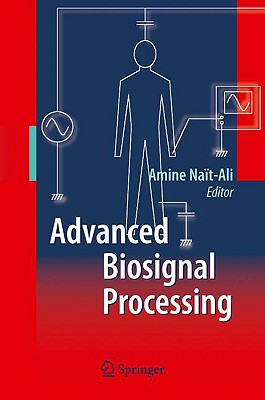
Advanced Biosignal Processing
Hardcover
Medical ReferenceGeneral ComputersGeneral Mathematics
Currently unavailable to order
Please enter your email and a message will be sent to you when this product becomes available on our website.
ISBN13: 9783540895053
Publisher: Springer Pg
Published: Apr 7 2009
Pages: 378
Weight: 1.90
Height: 1.10 Width: 9.40 Depth: 6.40
Language: English
1 different editions
Also available
Also in
Medical Reference
Virus Hunter: Thirty Years of Battling Hot Viruses Around the World
Peters, C. J.
Olshaker, Mark
Paperback
The Body Keeps the Score: Brain, Mind, and Body in the Healing of Trauma
Van Der Kolk, Bessel
Paperback
The New Menopause: Navigating Your Path Through Hormonal Change with Purpose, Power, and Facts
Haver, Mary Claire
Hardcover
Overcoming Acute and Chronic Pain: Keys to Treatment Based on Your Emotional Type
Dibra, Sebhia Marie
Micozzi, Marc S.
Paperback
Nursing Teas 7: A Quickstudy Laminated Reference Guide
Davis, April Michelle
Henry, Julie
Herrin, Jennifer
Other
Working The Roots: Over 400 Years of Traditional African American Healing
Lee, Michele Elizabeth
Paperback
It Hurts When I Poop!: A Story for Children Who Are Scared to Use the Potty
Bennett, Howard J.
Hardcover
The Complete Native American Healing Herbs Encyclopedia - 7 Books in 1
Garcia Navarro, Hialeah
Paperback
How to Forage for Mushrooms Without Dying: An Absolute Beginner's Guide to Identifying 29 Wild, Edible Mushrooms
Hyman, Frank
Paperback
Heal Your Gut, Save Your Brain: The Five Pillars of Enhancing Your Gut and Optimizing Your Cognitive Health
Nandi, Partha
Hardcover
The Ultimate Survival Medicine Guide: Emergency Preparedness for Any Disaster
Alton, Amy
Alton, Joseph
Paperback
Longevity Guidebook: How to Slow, Stop, and Reverse Aging - and NOT Die from Something Stupid
Diamandis, Peter H.
Hardcover
Integrating a Palliative Approach Workbook 2nd Edition, Revised: Essentials For Personal Support workers
Murray, Katherine
Paperback
Period Repair Manual: Natural Treatment for Better Hormones and Better Periods
Briden Nd, Lara
Paperback
Shoulder Pain? The Solution & Prevention: Fifth Edition, Revised & Expanded
Kirsch, John M.
Paperback
The Dysautonomia Project: Understanding Autonomic Nervous System Disorders for Physicians and Patients
Goldstein, Phd
Thompson, Charles R.
Freeman, Msm Kelly
Paperback
The Good Death: A Guide for Supporting Your Loved One Through the End of Life
O'Brien, Suzanne B.
Hardcover
Murder by Injection: The Story of the Medical Conspiracy Against America
Mullins, Eustace Clarence
Paperback
Ob/GYN Peds Notes: Nurse's Clinical Pocket Guide
Kratovil, Amanda
Holloway, Brenda Walters
Moredich, Cheryl
Paperback
What Happened to You?: Conversations on Trauma, Resilience, and Healing
Perry, Bruce D.
Winfrey, Oprah
Hardcover
The Gut-Brain Paradox: Improve Your Mood, Clear Brain Fog, and Reverse Disease by Healing Your Microbiome
Gundry MD, Steven R.
Hardcover
Diagnostic and Statistical Manual of Mental Disorders, Fifth Edition, Text Revision (Dsm-5-Tr(r))
American Psychiatric
Paperback
The Vaccine-Friendly Plan: Dr. Paul's Safe and Effective Approach to Immunity and Health-From Pregnancy Through Your Child's Teen Years
Margulis, Jennifer
Thomas, Paul
Paperback
Dissolving Illusions: Disease, Vaccines, and The Forgotten History
Bystrianyk, Roman
Humphries, Suzanne
Paperback
Estrogen Matters: Why Taking Hormones in Menopause Can Improve and Lengthen Women's Lives -- Without Raising the Risk of Breast Cancer (2024 Revised a
Bluming, Avrum
Tavris, Carol
Hardcover
The Mindful Self-Compassion Workbook: A Proven Way to Accept Yourself, Build Inner Strength, and Thrive
Neff, Kristin
Germer, Christopher
Paperback
Current Medical Diagnosis and Treatment 2025
McQuaid, Kenneth R.
Papadakis, Maxine A.
Rabow, Michael W.
Paperback
The 36-Hour Day: A Family Guide to Caring for People Who Have Alzheimer Disease and Other Dementias
Rabins, Peter V.
Mace, Nancy L.
Paperback
All Creatures Great and Small: The Warm and Joyful Memoirs of the World's Most Beloved Animal Doctor
Herriot, James
Paperback
Clean -- Expanded Edition: The Revolutionary Program to Restore the Body's Natural Ability to Heal Itself
Junger, Alejandro
Paperback
The Winning Brief: 100 Tips for Persuasive Briefing in Trial and Appellate Courts
Garner, Bryan A.
Hardcover
The Pfizer Papers: Pfizer's Crimes Against Humanity
The Warroom/Dailyclout Pfizer Documents Analysts
Hardcover
Anatomy Coloring Book with 450+ Realistic Medical Illustrations with Quizzes for Each
Wise, Eric
McCann, Stephanie
Paperback
God's Hotel: A Doctor, a Hospital, and a Pilgrimage to the Heart of Medicine
Sweet, Victoria
Paperback
Booster Shots: The Urgent Lessons of Measles and the Uncertain Future of Children's Health
Ratner, Adam
Hardcover
Plain Language Big Book: A Tool for Reading Alcoholics Anonymous
Alcoholics Anonymous World Services Inc
Paperback
Dying of Whiteness: How the Politics of Racial Resentment Is Killing America's Heartland
Metzl, Jonathan M.
Paperback
Reversing Alzheimer's: The New Toolkit to Improve Cognition and Protect Brain Health
Sandison, Heather
Hardcover
Medical Apartheid: The Dark History of Medical Experimentation on Black Americans from Colonial Times to the Present
Washington, Harriet A.
Paperback
Another World Is Possible: Lessons for America from Around the Globe
Hakimi Zapata, Natasha
Hardcover
Dho Health Science, Student Workbook
Simmers, Louise
Simmers-Nartker, Karen
Simmers-Kobelak, Sharon
Paperback
The End of Alzheimer's Program: The First Protocol to Enhance Cognition and Reverse Decline at Any Age
Bredesen, Dale
Paperback
Mastering Diabetes: The Revolutionary Method to Reverse Insulin Resistance Permanently in Type 1, Type 1.5, Type 2, Prediabetes, and Gesta
Barbaro, Robby
Khambatta, Cyrus
Paperback
Cialis Men's Usage Manual: Men's Long-Lasting Erection Pills: Quick-acting, Stay and Get Rock Hard, Unadulterated Mind-Blowing Climax
Petersson, Nicolas
Paperback
Taking Charge of Adult ADHD: Proven Strategies to Succeed at Work, at Home, and in Relationships
Barkley, Russell A.
Paperback
Everything Is Tuberculosis: The History and Persistence of Our Deadliest Infection (Large Print Edition)
Green, John
Paperback
Mindful Self-Compassion for Burnout: Tools to Help You Heal and Recharge When You're Wrung Out by Stress
Germer, Christopher
Neff, Kristin
Paperback
The Apothecary's Wife: The Hidden History of Medicine and How It Became a Commodity
Gevirtz, Karen Bloom
Hardcover
Other Minds: The Octopus, the Sea, and the Deep Origins of Consciousness
Godfrey-Smith, Peter
Paperback
Child Medication Fact Book for Psychiatric Practice, Second Edition
Puzantian, Talia
Tien, Elizabeth
Feder, Joshua D.
Paperback
Trauma and Recovery: The Aftermath of Violence--From Domestic Abuse to Political Terror
Herman, Judith Lewis
Paperback
Pcos SOS: A Gynecologist's Lifeline To Naturally Restore Your Rhythms, Hormones, and Happiness
Gersh, Felice
Perella, Alexis
Paperback
The Boy Who Was Raised as a Dog: And Other Stories from a Child Psychiatrist's Notebook -- What Traumatized Children Can Teach Us about Loss, Love, an
Perry, Bruce D.
Szalavitz, Maia
Paperback
How to Change Your Mind: What the New Science of Psychedelics Teaches Us about Consciousness, Dying, Addiction, Depression, and Transcendence
Pollan, Michael
Paperback
Mayo Clinic Guide to Better Sleep: Find Relief from Insomnia, Sleep Apnea and Other Sleep Disorders
Prakash Kolla, Bhanu
Morgenthaler, Timothy I.
Hardcover
The New Evil: Understanding the Emergence of Modern Violent Crime
Brucato, Gary
Stone, Michael E.
Paperback
Yin & Yang Nutrition for Dogs: Maximizing Health with Whole Foods, Not Drugs
Morgan DVM, Judy
Grant, Hue
Paperback
The Addictive Personality: Understanding the Addictive Process and Compulsive Behavior
Nakken, Craig
Paperback
Hidden Epidemic: Silent Oral Infections Cause Most Heart Attacks and Breast Cancers
Levy, Jd
Paperback
Stem Cell Therapy: A Rising Tide: How Stem Cells Are Disrupting Medicine and Transforming Lives
Riordan, Neil H.
Paperback
Cocktail Codex: Fundamentals, Formulas, Evolutions [A Cocktail Recipe Book]
Fauchald, Nick
Day, Alex
Kaplan, David
Hardcover
Finally Focused: The Breakthrough Natural Treatment Plan for ADHD That Restores Attention, Minimizes Hyperactivity, and Helps Eliminate Drug Side Effe
Greenblatt, James
Gottlieb, Bill
Paperback
Surviving Cancer, COVID-19, and Disease: The Repurposed Drug Revolution (Large Print Edition)
Hope, Justus R.
Paperback
Judas Dentistry: How Dentists Scorn Science, Break the Hippocratic Oath, and Wreck Their Patients' Minds and Bodies
Yoho, (Ret) Robert
Paperback
The Anti-Inflammatory Diet Slow Cooker Cookbook: Prep-And-Go Recipes for Long-Term Healing
Given, Madeline
Paperback
Dissolving Illusions: Disease, Vaccines, and the Forgotten History 10th Anniversary Edition
Bystrianyk, Roman
Humphries, Suzanne
Paperback
The Forgotten Sense: The New Science of Smell--And the Extraordinary Power of the Nose
Olofsson, Jonas
Hardcover
Fasting Cancer: How Fasting and Nutritechnology Are Creating a Revolution in Cancer Prevention and Treatment
Longo, Valter
Hardcover
A Parent's Guide to Starting Psychiatric Medications for Kids: Start Low and Go Slow
Trelles, Pilar
Jaffe, Robert
Kolevzon, Alexander
Paperback
Destiny of the Republic: A Tale of Madness, Medicine and the Murder of a President
Millard, Candice
Paperback
The Obesity Code: Unlocking the Secrets of Weight Loss (Why Intermittent Fasting Is the Key to Controlling Your Weight)
Fung, Jason
Paperback
Anger Management Skills Workbook for Kids: 40 Awesome Activities to Help Children Calm Down, Cope, and Regain Control
Robinson, Amanda
Paperback
The Age of Diagnosis: How Our Obsession with Medical Labels Is Making Us Sicker
O'Sullivan, Suzanne
Hardcover
You Are Not Broken: A Compassionate Guide to Uncovering Inner Wisdom and Transforming Your Life with Hypnotherapy
Raymond, Sara
Paperback
Get What's Yours for Medicare - Revised and Updated: Maximize Your Coverage, Minimize Your Costs
Moeller, Philip
Hardcover
Witches, Midwives, & Nurses (Second Edition): A History of Women Healers
Ehrenreich, Barbara
English, Deirdre
Paperback
Accessing the Healing Power of the Vagus Nerve: Self-Help Exercises for Anxiety, Depression, Trauma, and Autism
Rosenbery, Stanley
Paperback
Herbal Medicine for Beginners: Your Guide to Healing Common Ailments with 35 Medicinal Herbs
Swift, Katja
Midura, Ryn
Paperback
Misoprostol En La Interrupcion Temprana del Embarazo En Adolescentes
Varona Sanchez Joel Alejandro
Paperback
It Starts with the Egg: The Science of Egg Quality for Fertility, Miscarriage, and IVF (Third Edition)
Fett, Rebecca
Paperback
I Hate Myself: Overcome Self-Loathing and Realize Why You're Wrong about You
Aguirre, Blaise
Hardcover
Women in White Coats: How the First Women Doctors Changed the World of Medicine
Campbell, Olivia
Paperback
Earthing (2nd Edition): The Most Important Health Discovery Ever!
Sinatra, Stephen T.
Zucker, Martin
Ober, Clinton
Paperback
The Black Angels: The Untold Story of the Nurses Who Helped Cure Tuberculosis
Smilios, Maria
Hardcover
Good Moms Have Scary Thoughts: A Healing Guide to the Secret Fears of New Mothers
Kleiman, Karen
Hardcover
The Living Medicine: How a Lifesaving Cure Was Nearly Lost--And Why It Will Rescue Us When Antibiotics Fail
Zeldovich, Lina
Hardcover
A Brief History of Intelligence: Evolution, Ai, and the Five Breakthroughs That Made Our Brains
Bennett, Max S.
Hardcover


 Sign-In
Sign-In Cart
Cart